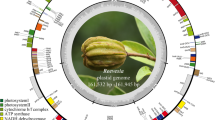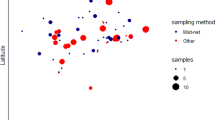Abstract
Sex determination in Armadillidium vulgare may be under the control of two parasitic sex factors that reverse genetic males into functional neo-females. The first feminizing factor (F) is a Wolbachia and the other (f) is probably a sequence of the F bacterial DNA unstably integrated into the host genome. Both of these feminizing factors are mainly maternally transmitted. Here we investigate the mitochondrial DNA polymorphism of wild iso-female lineages harbouring either F or f. Among the four haplotypes present in the population, two were the f-harbouring lineages, while two were common to the F- and f-harbouring lineages. This result suggests that there has been an introgression of the f factor into lineages infected by F Wolbachia. Based on previous data, we propose two different ways to account for such introgression. Given the particular dynamics of feminizing factors (f-harbouring lineages increase in populations at the expense of F-harbouring lineages), such an introgression should prevent the replacement of F-linked mitochondrial types by f-linked mitochondrial types in wild populations.
Similar content being viewed by others
References
BinningtonK.C. & A.A.Hoffmann, 1989. Wolbachia-like organisms and cytoplasmic incompatibility in Drosophila simulans. J. Invertebr. Pathol. 54: 344–352.
DawkinsR., 1976. The selfish gene. Oxford University Press, Oxford.
HaleL.R. & A.A.Hoffmann, 1990. Mitochondrial DNA and cytoplasmic incompatibility in natural populations of Drosophila simulans. Evolution 44: 1383–1386.
HurstL.D., 1993. The incidences, mechanisms and evolution of cytoplasmic sex ratio distorters in animals. Biol. Rev. 68: 121–193.
JuchaultP. & J.J.Legrand, 1981a. Contribution l'étude qualitative et quantitative des facteurs controlant le sexe dans les populations du Crustacé Isopode terrestre Armadillidium vulgare Latr. II—Populations hébergeant le facteur féminisant F (bactérie intracytoplasmique). Arch. Zool. Exp. Gén. 122: 65–74.
JuchaultP. & J.J.Legrand, 1981b. Contribution à l'étude qualitative et quantitative des facteurs controlant le sexe dans les populations du Crustacé Isopode terrestre Armadillidium vulgare Latr. III—Populations n' hébergeant pas le facteur féminisant F. Arch. Zool. Exp. Gén. 122: 117–131.
JuchaultP. & J.P.Mocquard, 1993. Transfer of a parasitic sex factor to the nuclear genome of the host: a hypothesis on the evolution of sex determining mechanisms in the terrestrial Isopod Armadillidium vulgare Latr. J. Evol. Biol. 6: 511–528.
JuchaultP., T.Rigaud & J.P.Mocquard, 1992. Evolution of sex determining mechanisms in a wild population of Armadillidium vulgare Latr. (Crustacea, Isopoda): competition between two feminizing parasitic sex factors. Heredity 69: 382–390.
KambhampatiS., K.S.Rai & D.M.Verleye, 1992. Frequencies of mitochondrial haplotypes in laboratory cage populations of mosquito, Aedes albopictus. Genetics 132: 205–209.
LegrandJ.J. & P.Juchault, 1984. Nouvelles données sur le déterminisme génétique et épigénétique de la monogénie chez le Crustacé Isopode terrestre Armadillidium vulgare Latr., Gén. Sél. Evol. 16: 57–84.
LegrandJ.J., E.Legrand-Hamelin & P.Juchault, 1987. Sex determination in Crustacea. Biol. Rev. 62: 439–470.
LouisC. & L.Nigro, 1989. Ultrastructural evidence of Wolbachia Rickettsiales in Drosophila simulans and their relationships with unidirectional cross-incompatibility. Invert. Pathol. 54: 39–44.
Maniatis, T., E.F. Fritsch & J. Sambrook, 1982. Molecular Cloning, a Laboratory Manual. Cold Spring Harbor N.D.
MartinG., P.Juchault & J.J.Legrand, 1973. Mise en évidence d'un micro-organisme intracytoplasmique symbiote de l'Oniscoïde Armadillidium vulgare L., dont la présence accompagne l'intersexualité ou la féminisation totale des mâles génétiques de la lignée thélygène. C. R. Acad. Sci. Paris 276: 2313–2316.
Montchamp-MoreauC., J.F.Ferveur & M.Jacques, 1991. Geographic distribution and inheritance of three cytoplasmic incompatibility types in Drosophila simulans. Genetics 129: 399–407.
NigroL. & T.Prout, 1990. Is there selection on RFLP differences in mitochondrial DNA? Genetics 125: 551–555.
NurU., J.H.Werren, D.Eickbush, W.Burke & T.Eickbush, 1988. A ‘selfish’ B chromosome that enhances its transmission by eliminating the paternal genome. Science 240: 512–514.
RaimondR., 1988. Etude du polymorphisme enzymatique dans cinq populations naturelles d'Armadillidium vulgare Latreille (Crustacea, Isopoda, Oniscidea), pp. 191–194 in Actes de Colloques: Aspects récents de la Biologie des Crustacés, Vol. 8, edited by L.LeGal and A.vanWormhoudt. IFREMER, France.
RigaudT., C.Souty-Grosset, R.Raimond, J.P.Mocquard & P.Juchault, 1991. Feminizing endocytobiosis in the terrestrial crustacean Armadillidium vulgare Latr. (Isopoda): recent acquisitions. Endocytobiosis Cell Res. 7: 259–273.
RigaudT., P.Juchault & J.P.Mocquard, 1991. Experimental study of temperature effects on sex ratio of broods in terrestrial crustacea Armadillidium vulgare Latr. Possible implications in natural populations. J. Evol. Biol. 4: 603–617.
RoussetF., D.Bouchon, B.Pintureau, P.Juchault & M.Solignac, 1992. Wolbachia endosymbionts responsible for various alterations of sexuality in arthropods. Proc. Roy. Soc. London B 250: 91–98.
SkinnerS.W., 1987. Paternal transmission of an extrachromosomal factor in a wasp: evolutionary implications. Heredity 59: 47–53.
SolignacM. & M.Monnerot, 1986. Race formation, speciation and introgression within Drosophila simulans and D. sechelia inferred from mitochondrial DNA analysis. Evolution 40: 531–539.
Souty-GrossetC., R.Raimond & M.Tourte, 1992. Déterminisme épigénétique du sexe et divergence génétique de l'ADN mitochondrial chez Armadillidium vulgare Latr. (Crustacé Oniscoïde): variabilité inter et intrapopulation. C. R. Acad. Sci. Paris 314: 119–125.
TaylorD.R., 1990. Evolutionary consequences of cytoplasmic sex ratio distorters. Evol. Ecol. 4: 235–248.
TurelliM., A.A.Hoffmann & S.W.McKechnie, 1992. Dynamics of cytoplasmic incompatibility and mtDNA variation in natural Drosophila simulans populations. Genetics 132: 713–224.
VandelA., 1941. Recherches sur la génétique et la sexualité des Isopodes terrestres. VI: Les phénomènes de monogénie chez les Oniscoïdes. Bull. Biol. France Belgique 75: 316–363.
WerrenJ.H., 1991. The paternal sex ratio chromosome of Nasonia. Am. Nat. 137: 392–402.
WerrenJ.H., U.Nur & C.Wu, 1988. Selfish genetic elements. Trends Ecol. Evol. 3: 297–302.
Author information
Authors and Affiliations
Rights and permissions
About this article
Cite this article
Grandjean, F., Rigaud, T., Raimond, R. et al. Mitochondrial DNA polymorphism and feminizing sex factors dynamics in a natural population of Armadillidium vulgare (Crustacea, Isopoda). Genetica 92, 55–60 (1993). https://doi.org/10.1007/BF00057507
Received:
Accepted:
Issue Date:
DOI: https://doi.org/10.1007/BF00057507




